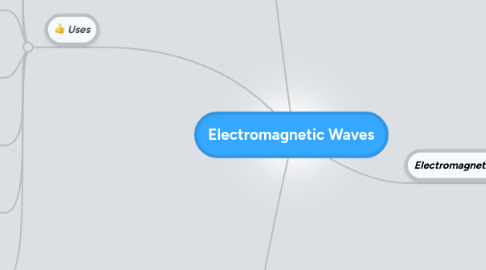
1. Propeties
1.1. Transverse waves
1.2. Does not require medium to propagate
1.3. Travel at a constant speed of 3.0 x 10^8 m/s
1.4. Obey laws of reflection and refraction
2. Uses
2.1. Radio waves
2.1.1. Radio broadcasting
2.1.2. Transmitting television prgrammes
2.1.3. Telecommunication
2.1.4. Wireless networking
2.2. Microwaves
2.2.1. Remote sensing
2.2.2. For cooking food
2.3. Infrared
2.3.1. Thermal imaging
2.3.2. Night vision binoculars
2.4. Visible light
2.4.1. Photography
2.4.2. Endoscopy
2.5. Ultraviolet rays
2.5.1. Fluorescence effect
2.5.2. Sunbeds
2.6. X-rays
2.6.1. Radiography
2.6.2. Detecting cracks in pipes and buildings
2.7. Gamma rays
2.7.1. Radiotherapy
2.7.2. Sterilisation of medical equipment
3. Harmful effects
3.1. Ionisation radiation
3.1.1. High energy electromagnetic waves such as Ultraviolet rays, X-rays and gamma rays
3.1.1.1. Cause electrons to gain enrgy and escape from the atoms.
3.1.1.1.1. Atoms become charged and unstable
4. Electromagnetic Spectrum
4.1. Radio waves
4.1.1. Lowest frequencies and longest wavelengths
4.1.2. Used for transmission of signals and datas. An antenna is used to receive these signals.
4.2. Microwaves
4.2.1. Easy to control and direct
4.2.2. In a microwave oven, absorbed microwaves cause water molecules in the food to vibrate rapidly, which then heats up the food.
4.3. Infrared
4.3.1. Produced by hot objects
4.3.2. Some animals can see in infrared red light to enable them to detect warm-blooded animals.
4.4. Visible light
4.4.1. Produced by luminous objects
4.4.2. Crucial for normal human sight
4.4.3. Used in data transfer in telecommunications and by electronic devices such as television sets and computer monitors
4.5. Ultraviolet rays
4.5.1. The human skin produces vitamin D naturally when exposed to ultraviolet rays.
4.5.2. Also causes tanning by stimulating the production of the skin pigment known as melanin. Can cause sunburn.
4.5.3. Some chemicals absorb ultraviolet radiation and then appear to be glowing. This fluorescence effect is used to create markings on bank notes, paints and dyes.
4.6. X-rays
4.6.1. High frequencies
4.6.2. Able to penetrate many materials
4.6.3. Used in the medical field to obtain images of the internal parts of our bodies.
4.7. Gamma rays
4.7.1. Waves with the highest frequency and most energy
4.7.2. Dangerous rays coming from nuclear explosions and atomic bombs, they can cause cell and tissue injury.
4.7.3. As they can cause damage to living cells, they are used in the medical field to kill cancer cells
